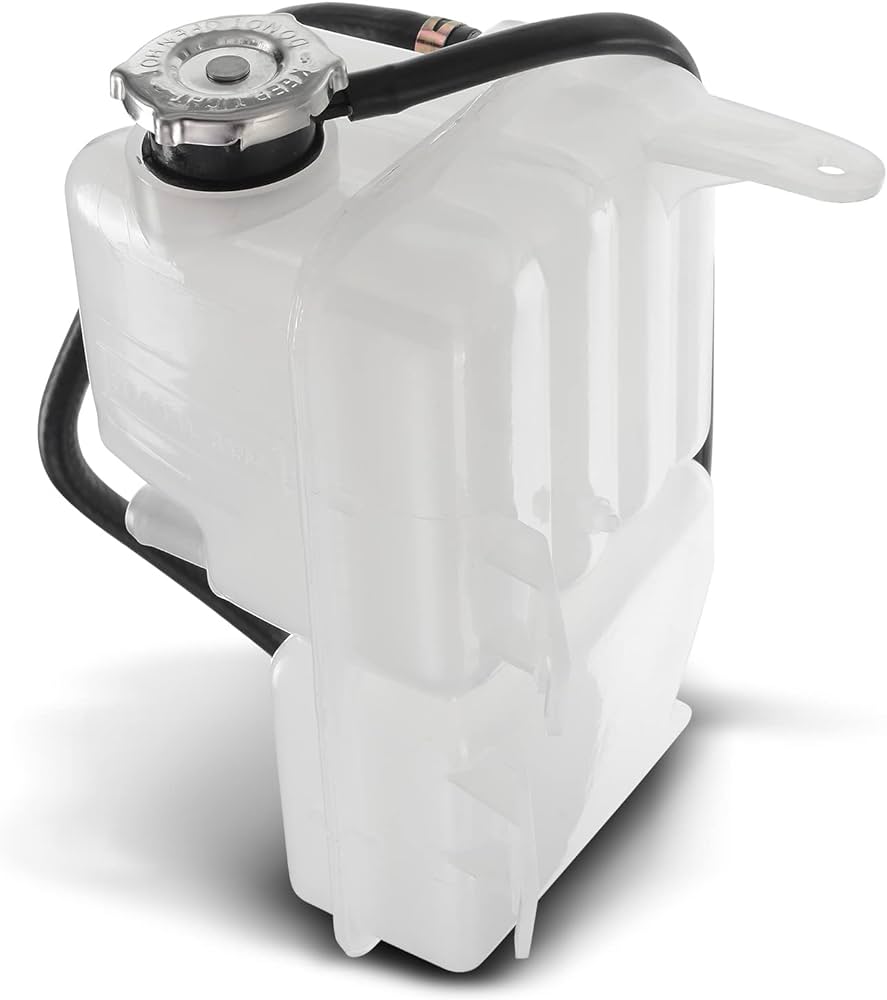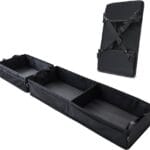How Much Antifreeze Does a Ford F150 Hold? Find Out the Exact Capacity!
A Ford F150 typically holds around 12 quarts of antifreeze or coolant in its radiator. Smaller engines may require less coolant.
It’s important to consult the owner’s guide for the specific coolant capacity of your truck.

Understanding Antifreeze Capacity For Ford F150
The Ford F150 has a coolant capacity of approximately two gallons, consisting of equal amounts of antifreeze/coolant and water. Smaller engines may require less coolant.
When it comes to maintaining your Ford F150, understanding the antifreeze capacity is crucial. Antifreeze, also known as coolant, plays a vital role in keeping your engine running smoothly and preventing it from freezing during colder temperatures. Knowing how much antifreeze your Ford F150 can hold is essential for proper maintenance and ensuring the longevity of your vehicle.
Factors Affecting Antifreeze Capacity
Several factors come into play when determining the antifreeze capacity of your Ford F150:
- Engine Size: The size of your engine directly impacts the amount of coolant it can hold. Larger engines generally tend to accommodate more antifreeze compared to smaller engines.
- Cooling System Design: The design and configuration of the cooling system in your Ford F150 can affect the antifreeze capacity. Some models may have larger radiators or additional cooling components, allowing for a higher coolant volume.
- Model Year: Different model years of the Ford F150 may have varying cooling system capacities. It is important to refer to your specific vehicle’s documentation or consult a reliable source to determine the exact antifreeze capacity.
Importance Of Knowing The Antifreeze Capacity
Understanding the antifreeze capacity of your Ford F150 is essential for several reasons:
- Optimal Engine Performance: Maintaining the correct amount of antifreeze ensures optimal engine performance by preventing overheating and freezing, which can lead to engine damage.
- Preventing Corrosion and Rust: The right antifreeze-to-water ratio helps to prevent corrosion and rust within the cooling system, extending the lifespan of vital components.
- Economic Efficiency: Knowing the antifreeze capacity allows you to purchase the right amount of coolant, preventing waste and unnecessary expenses.
- Proper Maintenance: By understanding the antifreeze capacity, you can properly maintain your vehicle by regularly checking and topping up the coolant level.
By considering the factors that affect antifreeze capacity and recognizing the importance of knowing it, you can ensure the longevity and reliability of your Ford F150. Refer to your vehicle’s documentation or consult a reliable source to determine the specific antifreeze capacity for your Ford F150 model year. Regularly monitoring and maintaining the coolant level will help keep your engine in optimal condition, providing you with a smooth and trouble-free driving experience.
Determining The Antifreeze Capacity For Ford F150
Determining the antifreeze capacity for a Ford F150 is essential for maintaining the cooling system. The amount of antifreeze that a Ford F150 can hold varies based on the engine size, but it typically requires around two gallons of antifreeze/coolant and an equal amount of water.
Checking The Owner’s Manual
One of the easiest ways to determine the antifreeze capacity for your Ford F150 is by checking the owner’s manual. The owner’s manual contains all the necessary information about your vehicle, including the correct antifreeze capacity. Look for the section on cooling system specifications or fluid capacities, and you should find the exact amount of antifreeze your Ford F150 needs. Be sure to check the manual specific to your vehicle’s model and year for accurate information.
Consulting Online Resources
If you don’t have access to the owner’s manual or if you prefer to find the information online, there are various resources available that can help you determine the antifreeze capacity for your Ford F150. Automotive websites, forums, and community groups dedicated to Ford vehicles often have discussions and threads where enthusiasts share their knowledge and experiences. These online resources can provide valuable insights and guidance on the antifreeze capacity for your specific Ford F150 model and year.
Contacting Ford Service
If you want to be sure about the antifreeze capacity for your Ford F150, there is no better source of information than the manufacturer itself. Contacting the official Ford Service can provide you with accurate and up-to-date data on the recommended antifreeze capacity for your vehicle. You can reach out to Ford Service through its website or by calling their customer service helpline. Make sure to provide the necessary details about your Ford F150, such as the model, year, and any additional variations or features that might apply to your vehicle.
Common Antifreeze Capacity For Ford F150 Models
If you own a Ford F150 and are wondering how much antifreeze it holds, you’ve come to the right place. Knowing the antifreeze capacity of your truck is important for proper maintenance and avoiding any overheating issues. In this article, we will outline the common antifreeze capacities for different Ford F150 models, including the 2013, 2002, 1995, 1999, and 2001 models.
Antifreeze Capacity For 2013 Ford F150
For the 2013 Ford F150 model, the antifreeze capacity may vary depending on the engine size and other factors. On average, the 2013 Ford F150 holds about X gallons of antifreeze. It is recommended to check the owner’s manual or consult with a professional to get the exact capacity for your specific model.
Antifreeze Capacity For 2002 Ford F150
The 2002 Ford F150 typically has an antifreeze capacity of Y gallons. However, similar to the 2013 model, it is always recommended to refer to the owner’s manual or consult with a professional for the exact capacity.
Antifreeze Capacity For 1995 Ford F150
Owners of the 1995 Ford F150 can expect an antifreeze capacity of Z gallons. Remember to refer to the owner’s manual or seek expert advice to ensure accuracy.
Antifreeze Capacity For 1999 Ford F150
For the 1999 Ford F150 model, the antifreeze capacity is typically A gallons. However, it’s crucial to confirm the exact capacity by referring to the owner’s manual or consulting with a professional.
Antifreeze Capacity For 2001 Ford F150
The 2001 Ford F150 generally holds around B gallons of antifreeze. As with any model, it’s essential to verify this information through the owner’s manual or expert guidance.
Remember, the antifreeze capacity mentioned above is approximate and can vary depending on different factors. Always consult the owner’s manual or seek professional advice for the specific antifreeze capacity of your Ford F150 model. Proper maintenance of the cooling system is crucial for the overall health and performance of your truck.

How To Fill The Cooling System With Antifreeze
To fill the cooling system with antifreeze in a Ford F150, you will typically need around two gallons of antifreeze/coolant and an equal amount of water. Smaller engines may require less coolant. Be sure to follow the proper steps to bleed the air from the system and readjust the coolant level.
Bleeding The Coolant System
One important step in the process of filling the cooling system with antifreeze is bleeding the coolant system. This ensures that any trapped air is removed, preventing potential overheating issues. To bleed the coolant system, follow these simple steps:
- Start by locating the bleeder valve. It is usually located near the top of the engine, on a hose, or near the thermostat housing.
- Place a catch pan or container underneath the valve to collect any coolant that may come out.
- Using a wrench or pliers, slowly open the bleeder valve. You should hear a hissing sound as the pressure is released.
- Allow the coolant to flow until there are no more air bubbles present. This may take a few minutes.
- Once no more air bubbles are observed, close the bleeder valve tightly.
- Check the coolant level in the radiator and top it off if necessary.
Cleaning The Cooling System
Before filling the cooling system with antifreeze, it is essential to clean the system to remove any debris or contaminants. Follow these steps to clean the cooling system:
- First, drain the old coolant from the radiator by opening the drain valve at the bottom.
- Flush the radiator with water to remove any built-up sediment or residue. You can use a garden hose for this.
- Continue flushing until the water runs clear and free of debris.
- Once the radiator is clean, close the drain valve tightly.
Filling The Cooling System With Antifreeze
Now that the cooling system is clean, it’s time to fill it with antifreeze. Follow these steps:
- Refer to your vehicle’s manual or check the specifications online to determine the recommended antifreeze-to-water ratio for your Ford F150 model.
- Prepare a mixture of antifreeze and water according to the recommended ratio.
- Remove the radiator cap and locate the coolant reservoir.
- Pour the mixture into the coolant reservoir until it reaches the maximum fill line.
- Replace the radiator cap and make sure it is securely tightened.
Bleeding Air From The Cooling System
After filling the cooling system with antifreeze, it is important to bleed any remaining air to ensure proper circulation. Follow these steps:
- With the engine still cool, open the radiator cap slowly to release any built-up pressure.
- Start the engine and let it idle for a few minutes.
- Observe the coolant level in the radiator and add more if necessary.
- Continuously monitor the coolant level and add more as needed during the bleeding process.
- Once no more air bubbles are observed and the coolant level remains steady, close the radiator cap tightly.
Readjusting The Antifreeze Level
After bleeding the air from the cooling system, it is important to readjust the antifreeze level to ensure the correct mixture. Follow these steps:
- Allow the engine to cool down completely.
- Check the coolant reservoir and top it off if necessary.
- Inspect the coolant level in the radiator and add more if needed.
- Ensure that the coolant level is within the recommended range.
- Double-check all connections and ensure that the caps are tightly secured.
Following these steps will help you properly fill the cooling system with antifreeze in your Ford F150 and ensure optimal engine performance.
Tips For Maintaining Antifreeze Levels In Ford F150
Maintaining antifreeze levels in a Ford F-150 is important for optimal engine performance. The amount of antifreeze/coolant required varies depending on the engine size, but it can range from two to four gallons. Regularly checking and topping up the coolant levels is crucial to prevent overheating and ensure smooth operation.
Regularly Checking Antifreeze Level
To maintain the optimal performance of your Ford F150’s cooling system, it is essential to regularly check the antifreeze level. By doing this, you can ensure that there is enough coolant to prevent overheating and protect the engine from freezing during colder months. Remember to check the antifreeze level when the engine is cool to avoid burns. If the level is low, top it up with the appropriate mixture of antifreeze and water.
Inspecting For Leaks
In addition to regularly checking the antifreeze level, it is crucial to inspect the cooling system for leaks. Leaks can lead to a loss of coolant, resulting in an inadequate amount of antifreeze to keep the engine at the right temperature. Look for signs of coolant puddling under the vehicle or any visible cracks or damage in the hoses, radiator, or water pump. If you notice any leaks, address them promptly to prevent further damage to your Ford F150.
Using The Correct Type Of Antifreeze
Using the correct type of antifreeze is vital for maintaining the effectiveness of your Ford F150’s cooling system. Different engines may require specific antifreeze formulations, such as green, red, or orange coolant. Consult your owner’s manual or reach out to a Ford dealership to determine the correct type of antifreeze recommended for your specific Ford F150 model and year.
Flushing The Cooling System
Over time, the antifreeze in your Ford F150 can become contaminated with dirt, rust, and other particles. This can hinder its ability to cool the engine effectively. Regularly flushing the cooling system can help remove these contaminants and ensure that the antifreeze is functioning optimally. Consider flushing the cooling system according to the manufacturer’s recommended intervals to maintain the longevity of your Ford F150’s cooling system.
Following Manufacturer’s Recommendations
Finally, it is crucial to always follow the manufacturer’s recommendations when it comes to maintaining antifreeze levels in your Ford F150. These recommendations may include specific intervals for flushing the cooling system, using a particular type of antifreeze, or changing the coolant entirely. Adhering to these recommendations will help ensure that your cooling system operates at its best and avoid potential engine damage due to inadequate antifreeze levels.

Frequently Asked Questions: How Much Antifreeze Does A Ford F150 Hold
How Much Coolant Does A F150 5.0 Take?
The F150 5 0 typically takes around two gallons of coolant/antifreeze and the same amount of water to fill the radiator. Smaller engines will require less coolant.
How Many Gallons Of Antifreeze Does It Take To Fill A Radiator?
For larger engines, it can take up to two gallons of antifreeze/coolant to fill a radiator, along with approximately the same amount of water. Smaller engines typically require less coolant.
How Much Coolant Does A 2008 Ford F150 4.6 Take?
A 2008 Ford F150 4. 6L engine typically requires approximately two gallons of coolant/antifreeze and the same amount of water to fill the radiator. Smaller engines will need less coolant.
How Much Antifreeze Should I Put In My Truck?
For most trucks, you will need approximately two gallons of antifreeze/coolant and the same amount of water to fill the radiator to the right level. Smaller engines may require less coolant. It’s best to consult your owner’s manual for the specific coolant capacity of your truck.
Conclusion
To determine how much antifreeze your Ford F150 can hold, it’s crucial to consider factors such as engine size, radiator capacity, and overall coolant capacity. While smaller engines may require less coolant, larger engines could use up to two gallons of antifreeze/coolant, along with a similar amount of water.
To find the exact specifications for your specific model, it’s best to consult the owner’s guide or reach out to a trusted Ford dealership. Remember, maintaining the proper coolant level is essential for the optimal performance and longevity of your vehicle.

















